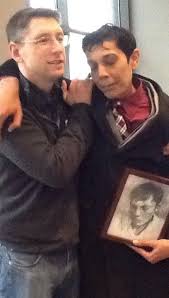Featured Image: Marc Nelson (left) is an Illinois-based artist whose work documents the war crimes, and human rights violations occurring in Syria, Yemen, Myanmar, and the United States, and is featured in the exhibition. He is pictured with his friend and martyr of revolution Mazen Al-Hamada, whose verbal and visual testimony are also featured. Mazen was forcibly disappeared and later murdered in the “slaughterhouse” prison of Saydnaya in Damascus, only days before the toppling of the Assad regime.
CW: Depictions of Torture (Illustrated) and Discussions of Carceral Violence, Torture, and Death
The notion of human nature implies certain universalities amongst all people, suggesting an intangible connection between everyone who has ever lived, everyone alive now, and everyone who has yet to live. The tangible products of creative expression that we call art could be described as the physical manifestations of human nature. Thus, an artist’s humanity and identity become immortalized by their act of creation.
But what about those who cannot create art freely? Whose voices are silenced by carceral institutions designed to dehumanize and disenfranchise? Human nature does not simply vanish, and neither do those who are incarcerated.
A Prison, a Prisoner, and a Prison Guard: An Exploration of Carcerality in the Middle East and North Africa (MENA) is only the second exhibition I have encountered dedicated solely to incarcerated and prison-impacted artists and communities, a troubling reality I believe reflects the overwhelmingly negative Western and global attitudes towards incarcerated people.
Curators Susan Aboeid and Sumaya Tabbah of The Hafathah Collective, with organizational collaboration from U-M Students Organize for Syria (SOS), in partnership with U-M Library, and with support from the U-M Arts Initiative, have created one of the most poignant traveling exhibitions I have ever had the privilege of viewing. The geographic coverage of the MENA region is extensive, with prison art from Algeria, Egypt, Iran, Iraq, Lebanon, Palestine, Sudan, Syria, and Yemen, effectively revealing the devastatingly similar carceral realities of these countries. The exhibition, however, resists exceptionalism by asserting that prisons in the MENA region are not bad because the area is bad, but because the prisons and those who run them are detestable.  Untitled by Unknown, Undated, Yemen is a visual testimony smuggled out of prison by an unknown artist, depicting methods of systematic mass torture implemented in UAE-run prisons in Yemen. This piece grapples with the exhibition’s tension of understanding prison art as testimony versus aesthetic, the former allowing the works to transcend carceral geographies and speak to the visitors, who in turn, speak to each other. Thus, the gallery becomes a space for those who have survived these prisons but can’t go back, a chance to reconcile their experiences and emotions.
Untitled by Unknown, Undated, Yemen is a visual testimony smuggled out of prison by an unknown artist, depicting methods of systematic mass torture implemented in UAE-run prisons in Yemen. This piece grapples with the exhibition’s tension of understanding prison art as testimony versus aesthetic, the former allowing the works to transcend carceral geographies and speak to the visitors, who in turn, speak to each other. Thus, the gallery becomes a space for those who have survived these prisons but can’t go back, a chance to reconcile their experiences and emotions. Another work, Broken Oaths by Razaan Killawi, 2021, Syria, depicts former Syrian president Bashar al-Assad atop excerpts from his inaugural address, “…a speech laced with assurances of unity, reform, and national pride — words that starkly contrast the realities of oppression, fear, and violence experienced by Syrians” reads the object label. Much like Assad weaponized language to legitimize injustice and oppression, the prison experience is carefully designed to legitimize the disintegration of communities under the false notion of “protection”. What is truly protected within these prisons is the truth — the truth about the unbearable reality so many people experience, which they can only later describe as “being suspended between life and death”.
Another work, Broken Oaths by Razaan Killawi, 2021, Syria, depicts former Syrian president Bashar al-Assad atop excerpts from his inaugural address, “…a speech laced with assurances of unity, reform, and national pride — words that starkly contrast the realities of oppression, fear, and violence experienced by Syrians” reads the object label. Much like Assad weaponized language to legitimize injustice and oppression, the prison experience is carefully designed to legitimize the disintegration of communities under the false notion of “protection”. What is truly protected within these prisons is the truth — the truth about the unbearable reality so many people experience, which they can only later describe as “being suspended between life and death”.
Whether we are separated by oceans and borders, language and culture, walls and bars, or armed guards and authoritarian regimes, we remain forever connected to our family and friends on the inside. This heart-wrenching exhibition, which will remain open until March 30th at the Hatcher Library at U-M, reminds those of us on the outside that those inside are still with us. I implore everyone who is able to take the opportunity to be with these artists through their immortal testimony, and hear their voices which will not be silenced.


